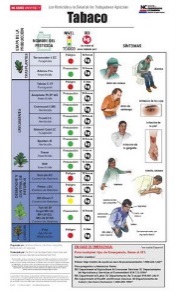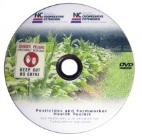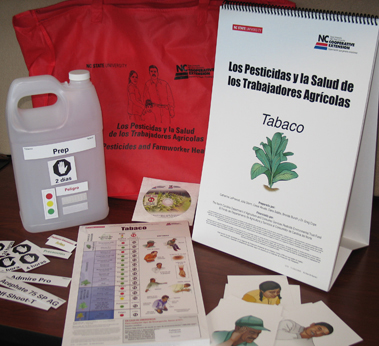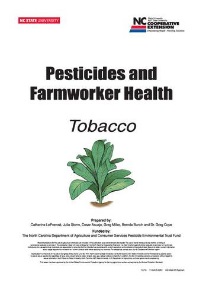 |
June 2014
|
June 2014 // Volume 52 // Number 3 // Ideas at Work // v52-3iw8
The Pesticides and Farmworker Health Toolkit: An Innovative Model for Developing an Evidence-Informed Program for a Low-Literacy, Latino Immigrant Audience
Abstract
Migrant and seasonal farmworkers are typically Spanish-speaking, Latino immigrants with limited formal education and low literacy skills and, as such, are a vulnerable population. We describe the development of the Pesticides and Farmworker Health Toolkit, a pesticide safety and health curriculum designed to communicate to farmworkers pesticide hazards found in their working environments. Using evidence-informed principles, the Toolkit curriculum for low-literacy, Latino farmworkers and its developmental process described herein serve as an innovative and useful model for Extension programming with non-traditional audiences.
Introduction
Migrant and seasonal farmworkers are a special risk population because of the cultural and linguistic barriers they face in maintaining safety and health at work (Donham & Thelin, 2006). Farmworkers in the United States (U.S.) are typically young to middle-aged males, foreign-born, and Spanish speaking (U.S. Department of Labor, 2005). The population can be characterized, generally, as having limited formal education and low literacy skills in Spanish and English (Tamassia, 2007).
The Pesticides and Farmworker Health Toolkit (Toolkit) (LePrevost et al., 2011) is a pesticide safety and health curriculum designed to communicate to farmworkers pesticide hazards found in their working environments. This comprehensive educational resource consists of a training flip chart, hands-on learning activities, and a take-home handout for learners, available in English and Spanish for 11 hand-labor intensive crops produced in the Southeastern U.S. (Table 1). Through an hour-long lesson, the materials highlight pesticide safety, hazard communication, exposure prevention, and health promotion messages focused on commonly used pesticides.
| Curricular Component | Image | Description |
| Flip Chart |
|
|
| Handout |

|
|
|
Hands-On Activities: Symptom Charade Cards, Jug and Jug Labels |

|
|
| DVD for Trainers |  |
|
|
Note: Curricular components are available for the following crops: apples, bell peppers, blueberries, Christmas trees, cucumbers, grapes, landscape/turf, strawberries, sweet potatoes, tobacco, and tomatoes. |
||
Evidence-based programs, as defined by Cooney, Huser, Small, and O-Connor (2007), require substantial resources and time to develop (Fetsch, MacPhee, & Boyer, 2012), while presenting unique challenges for the migrant farmworker population and other non-traditional Extension audiences. Small, Cooney, and O'Connor (2009) propose a practical alternative for program development with their evidence-informed principles. The Toolkit was developed with these principles and serves as a model for program development for low-literacy, Latino immigrant audiences.
Development Process
Engaging Stakeholders
The statewide need for a comprehensive educational resource to teach farmworkers pesticide safety and health was identified at a community stakeholder meeting held in North Carolina (N.C.) in 2007. Representatives from state (agriculture, labor, health, Extension) and non-profit (health, advocacy, commodity) organizations serving farmers and farmworkers attended. Stakeholders requested the development of a complete educational package consisting of crop-specific, bilingual materials, including pesticide safety lessons and associated take-home handouts that incorporated illustrations and minimal text. Later in 2007, the state Pesticide Board awarded a Pesticide Environmental Trust Fund grant for Toolkit curriculum development.
Creating and Evaluating a Prototype
A literature review informed the Toolkit's development; review findings suggested the need for pesticide education programs that are culturally responsive (Donham & Thelin, 2006), highly visual with the incorporation of realistic symbols (Glasnapp, Gabbard, & Nakamoto, 2006), and informed by farmworker input (Rother, 2008). Because N.C. is the largest producer of tobacco nationally and production occurs statewide (Krueger, 2011), tobacco served as the prototype crop for the Toolkit series. N.C. State University tobacco production specialists identified the most commonly used pesticides for inclusion in curriculum discussions regarding workplace hazards. Based on diverse images provided by the authors, a medical illustrator developed full-color illustrations of pesticide poisoning symptoms and tobacco plants at various growth stages. As described previously (LePrevost, Blanchard, Storm, Asuaje, & Cope, 2012), an iterative process of focused small group discussions and interviews with farmworkers took place during the 2008 and 2009 growing seasons in N.C. and Florida to develop effective visual curriculum components and assess farmworker understanding of associated safety concepts.
For the 2008 season, four graphic layouts and visual concepts for the take-home handout were produced with a graphic designer. After review, stakeholders selected two layouts for field-testing. A prototype lesson plan and corresponding flip chart were developed and produced based on adult education principles, social constructivist theory (Brooks, 1990) and health communication best practices (National Cancer Institute, n.d.). During field testing in 2008, using the evaluation concept described by Jayaratne (2007), four sample groups of N.C. farmworkers indicated their preferences for the handout layout by depositing a token in a box corresponding to their preferred handout design (Figure 1). Farmworker and trainer feedback, Toolkit developers' observations, and reviewers' suggestions during field-testing informed major flip chart revisions.
Figure 1.
Take-Home Handout Design for the Prototype Crop Tobacco Associated with the Pesticides and Farmworker Health Toolkit Selected by Farmworkers During Field Testing

In 2009, trainers from stakeholder organizations, who had themselves been trained by the authors (train-the-trainer concept), field tested the entire Toolkit curriculum. Flip charts, activities, and handouts were assessed by N.C. farmworkers and trainers. Based on trainer evaluation, curriculum content was expanded to include all worker training criteria mandated by the federal Worker Protection Standard (W.P.S.) (1992). In July 2010, Region 4 of the U.S. Environmental Protection Agency (E.P.A.) approved the Toolkit for W.P.S. worker training.
Expanding to Other Crops
The final content and designs of the tobacco prototype curriculum components were applied to the remaining 10 crops for expansion of the curriculum series. For each crop, production specialists identified the most commonly used pesticides and relevant production stages for organization of the lessons and handouts. The illustrator created crop production stage images for each crop. For all 10 crops, the prototype handout, flip chart, and hands-on activities were revised to reflect the production practices of each individual crop, resulting in complete crop-specific Toolkits.
Distributing to Users and Implementing Training
To date, more than 400 Toolkits have been disseminated in the southeastern U.S. and beyond. Through train-the-trainer workshops, over 175 individuals—including growers, landscapers, migrant and community health center outreach workers, state agency personnel, Extension agents, migrant education staff, and farmworker advocates—have become proficient Toolkit trainers.
Alignment with Evidence-Informed Principles
The Toolkit development process illustrates how a program for a low-literacy, non-English speaking, Latino, agricultural audience may be developed using evidence-informed principles, as described by Small et al. (2009). The Toolkit applied these principles (Table 2) in each of the four categories of program design and content, relevance, implementation, and assessment and quality assurance.
Evidence-Informed Principles |
Toolkit Attribute |
|
Program Design and Content |
Theory Driven |
Based on
|
Of Sufficient Dose and Intensity |
Meets experienced farmworker trainer recommended length and frequency
|
|
Comprehensive |
Consists of complete curriculum
|
|
Actively Engaging |
|
|
Program Relevance |
Developmentally Appropriate |
|
Appropriately Timed |
Trainings offered to farmworkers
|
|
Socioculturally Relevant |
|
|
Program Implementation |
Delivered by Well-Qualified, Trained, and Supported Staff |
Trainers prepared by
|
Focused on Fostering Good Relationships |
|
|
Program Assessment and Quality Assurance |
Well- Documented |
Fidelity of implementation facilitated by
|
Committed to Evaluation and Refinement |
|
|
Endorsed by Government Agency |
Approved by U.S. E.P.A. Region 4 for W.P.S. worker training (July 2010) |
|
Implications
There is a movement within Extension toward the use of evidence in the development and implementation of programs (Cooney et al., 2007; Fetsch et al., 2012). Simultaneously, Extension is increasingly aware of the need for culturally appropriate programs for Latino audiences, some of whom are low-literacy and non-English speaking (Herndon, Behnke, Navarro, Daniel, & Storm, 2013). Narrowly defined and rigorous evidence-based programs may not be feasible in all situations, particularly those involving non-traditional audiences. Therefore, evidence-informed program development—such as that described here for the Toolkit for a low-literacy, Latino farmworker audience—is a useful model for research-based, practical Extension programming.
Acknowledgments
We thank the farmworkers and collaborating organizations for their time in making this work possible. The first author's university institutional review board granted administrative approval for the project (IRB# 214-08-5). This project was funded by the Pesticide Environmental Trust Fund of the North Carolina Department of Agriculture and Consumer Services. We thank our Project Officer, Kay Harris, for her assistance.
References
Brooks, J. (1990, February). Teachers and students: Constructivists forging connections. Educational Leadership, 47(5), 68-71.
Cooney, S. M., Huser, M., Small, S. A., & O'Connor, C. (2007). Evidence-based programs: An overview. What Works, Wisconsin - Research to Practice Series, 6. Madison, WI: University of Wisconsin Extension. Retrieved from: http://www.uwex.edu/ces/flp/families/whatworks_06.pdf
Donham, K. J., & Thelin, A. (2006). Special risk populations in agricultural communities. In K. Donham & A. Thelin (Eds.), Agricultural medicine: Occupational and environmental health for the health professions (pp. 29-63). Ames, IA: Blackwell.
Fetsch, R. J., MacPhee, D., & Boyer, L. K. (2012). Evidence-based programming: What is a process an Extension agent can use to evaluate a program's effectiveness? Journal of Extension [On-line], 50(5) Article 5FEA2. Available at: http://www.joe.org/joe/2012october/a2.php
Glasnapp, J., Gabbard S., & Nakamoto J. (2006). Evaluation of the effectiveness of symbols and hazard communications materials: Final report: Phases I and II. Cincinnati, OH: National Risk Management Research Laboratory, Office of Research and Development.
Herndon, M. C., Behnke, A. O., Navarro, M., Daniel, J. B., & Storm, J. (2013). Needs and perceptions of cooperative extension educators serving Latino populations in the south. Journal of Extension [On-line], 51(1) Article 1FEA7. Available at: http://www.joe.org/joe/2013february/a7.php
Jayaratne, K. S. U. (2007). A practical tool for the evaluation of extension programs presented to older adults. Journal of Extension [On-line], 45(6) Article 6TOT2. Available at: http://www.joe.org/joe/2007december/tt2.php
Krueger, K. (2011). 2011 North Carolina agricultural statistics (Publication No. 213). Raleigh, NC: North Carolina Department of Agriculture and Consumer Services.
LePrevost, C. E., Blanchard, M. R., Storm, J. F., Asuaje, C. R, & Cope, W. G. (2012). Engaging Latino farmworkers in the development of symbols to improve pesticide safety and health education and risk communication. Journal of Immigrant and Minority Health, 15(5), 975-981.
LePrevost, C. E., Storm, J. F., Asuaje, C., Babbs, D., Bunch, B., & Cope. W. G. (2011). Pesticides and farmworker health toolkit for tobacco (Publication Nos. AG-Med-07 and -08; includes English and Spanish curricula, respectively). Raleigh, NC: North Carolina State University Cooperative Extension.
National Cancer Institute. (n.d.). Making health communication programs work: Planner's guide. Retrieved from: http://www.cancer.gov/cancertopics/cancerlibrary/pinkbook/Pink_Book.pdf
Rother, H. (2008). South African farm workers' interpretation of risk assessment data expressed as pictograms on pesticide label. Environmental Research, 108(3), 419-427.
Small, S. A., Cooney, S. M., & O'Connor, C. (2009). Evidence-informed program improvement: Using principles of effectiveness to enhance the quality and impact of family‐based prevention programs. Family Relations, 58(1), 1-13.
Tamassia, C., Lennon, M., Yamamoto, K., & Kirsch, I. (2007). Adult education in America: A first look at results from the adult education program and learner surveys. Retrieved from: http://www.ets.org/Media/Research/pdf/ETSLITERACY_AEPS_Report.pdf
United States Department of Labor, Office of the Assistant Secretary for Policy, Office of Programmatic Policy. (2005). Findings from the National Agricultural Workers Survey (NAWS) 2001-2001: A demographic and employment profile of United States farm workers (No. 9). Retrieved from: http://www.doleta.gov/agworker/report9/toc.cfm
Worker Protection Standard, 40 C.F.R. § 170.130 (1992).





